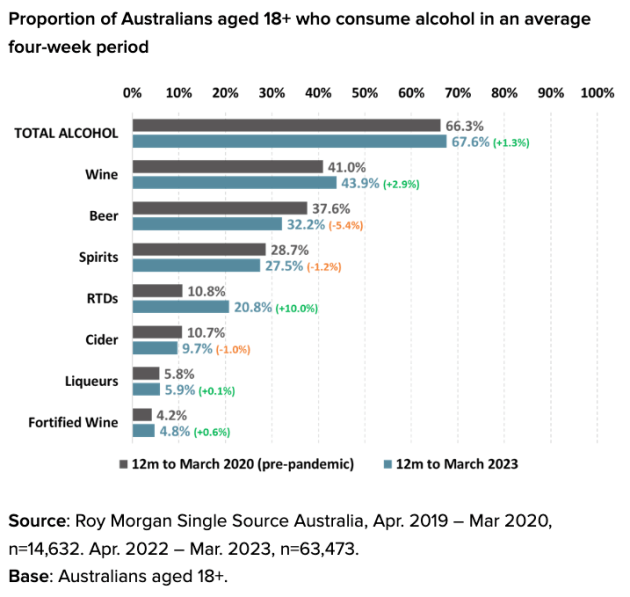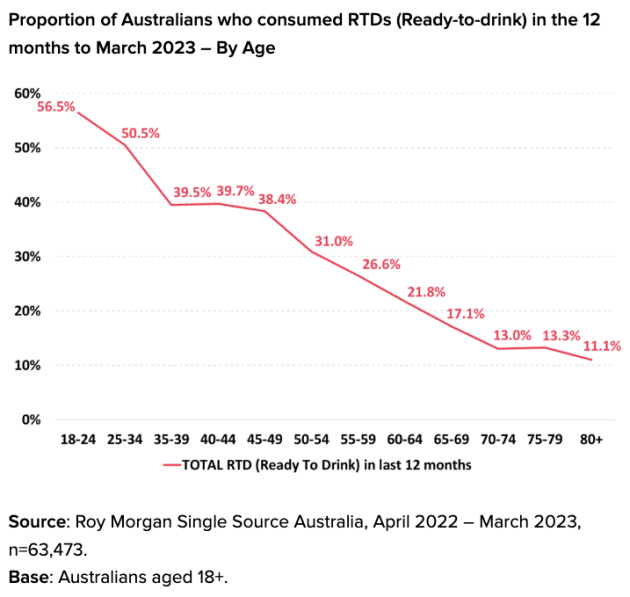The number of Australian adults consuming ready-to-drink (RTDs) beverages has almost doubled since 2020, with overall alcohol consumption still higher than pre-pandemic levels, but lower than the Covid peak in 2021/22, Roy Morgan’s latest Alcohol Consumption Report found.
In the 12 months to March 2023, just over two thirds (67.6 per cent) of Australians were consuming alcohol, which was 1.3 per cent higher – 636,000 people – than during the same period in 2020.
While Covid caused several changes in consumer behaviour – including an increase in alcohol consumption in 2020/21 – that peak has passed, dropping by 2.1 per cent (199,000 people) to the current level.
Roy Morgan CEO Michele Levine said the ‘shock’ of the pandemic disrupted a longer-term trend of declining alcohol consumption, which is now reasserting itself.
“In the year to June 2006 nearly three-quarters of Australian adults, 73.5 per cent, drunk an alcoholic beverage in an average four weeks,” Levine said.

While overall alcohol consumption is declining, the popularity of wine and ready-to-drink (RTDs) beverages has continued to rise.
“The standout performer of the last few years has been RTDs, which have kept increasing despite the ending of lockdowns and all pandemic-related restrictions. A record high 20.8 pre cent of Australians now drink RTDs in an average four weeks. This is up 5.8 per cent (1.2 million people) from a year ago and almost doubling (10 per cent, 2 million people) since March 2020,” she said.
The data showed more than one-in-two Australians aged 18-34 (52.7 per cent) and over one-in-three aged 35-49 (39.2 per cent) consumed RTDs in the 12 months to March 2023.
“This is up massively from 30.0 per cent for 18-34 year olds and 24.9 per cent for 35-49 year olds pre-pandemic.
“A deeper look into the RTDs market shows the increasing popularity of many drinks in this category including vodka, tequila, white rum, dark rum, whisky, cognac and also newer entrants such as alcoholic/hard seltzers which began to hit the Australian market in significant numbers in 2019, just before the pandemic struck.
“The growth for the new category of alcoholic/hard seltzers shows that exciting new alcoholic products can make an almost immediate impact on the marketplace,” Levine said.

Looking at the ‘big three’ alcohol types – wine, beer, and spirits – less than a third (32.2 per cent, 6.5 million people) of Australians now consume beer compared to the 12 months to March 2020 (37.6 per cent, 7.4 million people).
“The decline in beer drinking since 2005 has been more sustained than any other type of alcohol and the early signs are that the short-term pandemic impact on beer drinking has not been enough to halt the long-term trend,” Levine said.
The spirits category experienced its own pandemic boost with more than one million extra consumers in the 12 months to December 2021, but that has receded to below pre-pandemic levels, the data showed.
Meanwhile, while consumption of the big three is down, wine consumption is still higher than pre-pandemic levels.
“Wine remains the most popular alcoholic drink with 43.9 per cent of Australians adults drinking wine in an average four weeks. By age, those most likely to be drinking wine are aged 50-64 (49.9 per cent) and 65-79 (49.6 per cent).
“Roy Morgan will be keeping a close eye on the post-pandemic trends we are already seeing in the alcohol market during 2022-23. The emerging trends suggest consumption of wine and spirits looks set to return to pre-pandemic levels while RTDs such as vodka, gin, bourbon and rum have been on a sharp rise in recent years and that trend could well continue at the expense of beer consumption which has continued its long-term decline,” Levine said.






